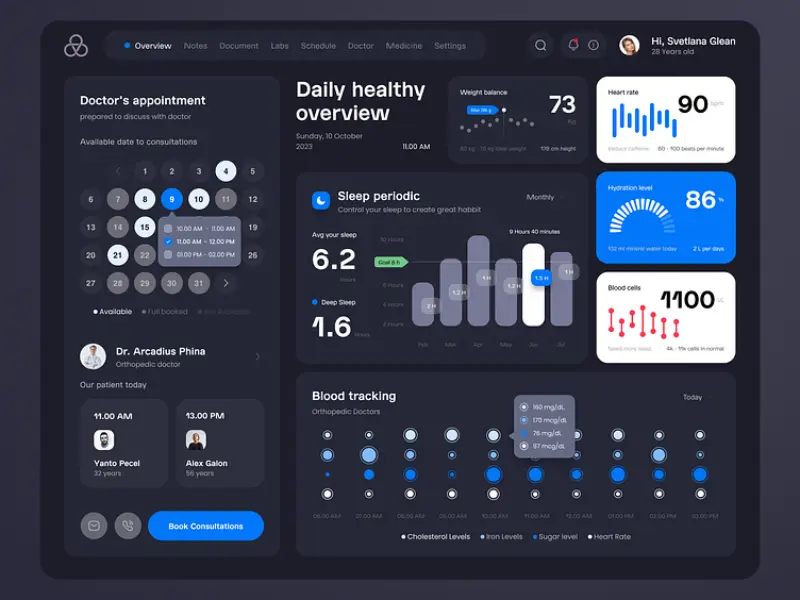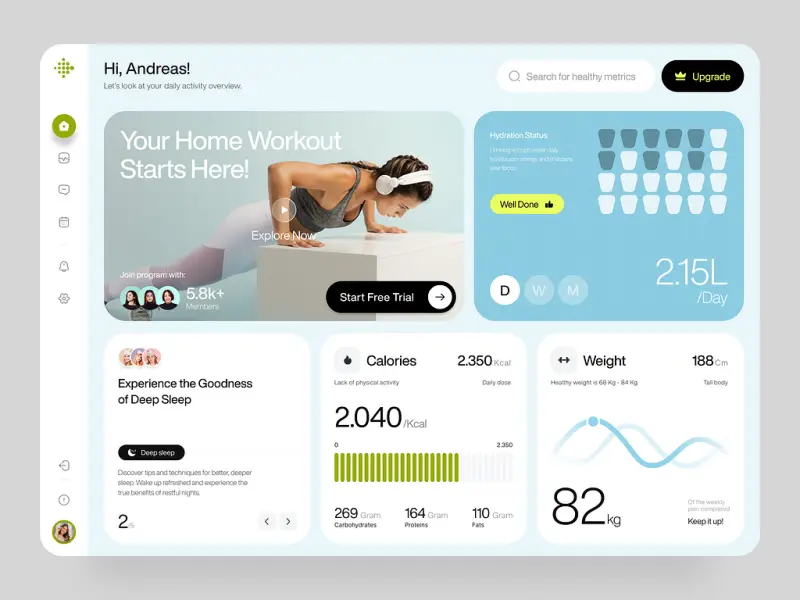A Guide to Software Testing in Healthcare for 2025
- TECHVIFY Team
- December 30, 2024
- Knowledge, Guides
- 0 Comments
The healthcare software development sector continues to thrive, generating nearly $600 billion in 2023 alone. These impressive figures highlight its growing significance—but they also signal big changes ahead. As the demand for quality healthcare software testing and development surges, there’s little room for error. In this fast-paced industry, production failures are simply unacceptable.
This is where rigorous software testing in healthcare comes into play. Thoughtful and thorough testing not only ensures patient safety and software reliability but also contributes to a more efficient and trustworthy healthcare ecosystem.
Today, we’ll take a closer look at actionable insights into healthcare software testing.
I. What Is Software Testing in Healthcare?
Software testing in healthcare ensures a software application’s quality, functionality, performance, and security while meeting the specific needs of its users. These applications can range from electronic health records (EHR) and telemedicine platforms to medical imaging systems and clinical decision-support tools.

Software testing in healthcare
By testing healthcare software, teams can verify that it meets the demands of end-users—such as patients, healthcare providers, insurers, regulators, and researchers—and complies with strict industry standards like HIPAA, FDA, GDPR, HL7, and DICOM. This process not only safeguards sensitive patient data but also protects healthcare institutions from potential compliance risks. At its core, healthcare software QA focuses on building reliable, high-quality solutions. At its core, healthcare software testing is about building trustworthy, high-quality solutions that prioritize safety and efficiency.
II. Weaknesses to Focus on in Healthcare Software Testing
Healthcare software isn’t like most other types of software—it’s deeply specialized, highly regulated, and directly impacts people’s well-being. That’s why testing healthcare solutions comes with unique challenges your team must address. Beyond the usual focus areas of software testing, there are specific weaknesses and vulnerabilities that require extra attention. Let’s explore them and how to overcome them.
- Usability Issues
Healthcare apps often prioritize functionality over user experience, resulting in interfaces that frustrate users like patients, doctors, or administrative staff. Poor usability can hinder adoption and even compromise patient care. Testing should ensure the app is intuitive, efficient, and frustration-free, creating a smooth experience that meets a diverse user base’s needs. - Unstable App Performance
Performance issues, such as slow loading times or crashes, can disrupt workflows and delay care—potentially putting lives at risk. Testing must account for real-world scenarios, including peak usage, diverse devices, and varying internet quality. By ensuring smooth performance under all conditions, you can build trust and reliability into your product. - Non-Compliance With HIPAA
Protecting sensitive patient data isn’t optional—it’s the law. Healthcare apps must meet rigorous HIPAA standards for security, privacy, and breach notifications. Failing to comply can lead to hefty fines, reputation damage, and loss of trust. Compliance testing ensures your app safeguards both patient data and your organization’s credibility. - Compatibility With Medical Software
Healthcare apps don’t operate in isolation—they must integrate seamlessly with systems like EHRs and HMS. This makes software testing in healthcare essential for ensuring smooth interoperability and accurate data exchange. Interoperability is essential for smooth workflows and accurate data exchange, even when dealing with outdated legacy systems. Compatibility testing ensures your app works with both modern and older systems, improving collaboration and patient care. - Compatibility With Hardware
Healthcare software must function across a range of devices, from laptops and smartphones to specialized medical equipment and wearables. Failing to connect with critical hardware can erode user trust. Comprehensive testing ensures your app works seamlessly with the tools healthcare providers and patients rely on daily, supporting real-time data exchange and stable connectivity.
III. Key Types of Healthcare Software Testing
Testing healthcare software isn’t just about running checks—it’s about evaluating the software from every possible angle to ensure safety, efficiency, and compliance. Comprehensive healthcare software testing services play a pivotal role in achieving these goals. Below are the essential types of testing to include in your plan:
1. Functional Testing
Functional testing ensures your healthcare software performs as expected based on its specified requirements. It answers the question: “Does this software do what it’s supposed to do?”
This type of testing also leverages automation tools, like regression testing, to keep costs and time in check. By automating repetitive tasks, testers can focus on verifying that new features or updates don’t interfere with existing functionality. The result? A high-quality, efficient, and reliable product that meets the needs of healthcare providers and patients alike.
Healthcare software QA
2. Performance and Scalability Testing
Healthcare software must work seamlessly, even under pressure. That’s where performance and scalability testing come in.
- Performance testing evaluates how the software performs under different load conditions. For example, how does it handle peak hospital hours when hundreds of providers access patient records simultaneously?
- Scalability testing checks if the software can handle growth, such as when a healthcare network adds new clinics or hospitals to its system.
These tests ensure that your software delivers smooth, reliable, and fast results, no matter the circumstances.
3. Security and Compliance Testing
In healthcare, data security and compliance are non-negotiable. From HIPAA in the U.S. to GDPR in Europe, healthcare software must meet strict regulations to protect sensitive patient information.
Security and compliance testing ensure your software has the right safeguards in place. Key areas include:
- Access controls to prevent unauthorized users,
- Data encryption to protect patient information, and
- Audit controls to monitor activity and ensure accountability.
By thoroughly testing these features, you can build a system that’s secure, compliant, and trusted by users.
4. Interoperability Testing
Modern healthcare relies on systems that can share and interpret medical data seamlessly. That’s why interoperability testing is critical.
This testing focuses on two main areas:
- Functional interoperability, which ensures accurate and complete data exchange between systems. For example, does a receiving system correctly interpret patient data from the originating system? This minimizes the risk of errors in diagnoses or treatments.
- Technical interoperability, which verifies that systems use compatible data formats and protocols (like HL7, FHIR, or DICOM). This prevents issues such as data corruption or communication failures.
With successful interoperability testing, you can create software that enables smooth collaboration across healthcare networks.
5. Usability and User Experience (UX) Testing
Healthcare software isn’t just for engineers—it’s for doctors, nurses, and even patients. That’s why usability and UX testing are so important.
- Usability testing focuses on how easy it is for users to navigate the software. Think: intuitive interfaces and efficient workflows that reduce errors and improve patient care.
- UX testing evaluates overall user satisfaction. For instance, does the software empower patients to manage appointments and prescriptions on their own? Does it help healthcare professionals streamline care delivery?
When done right, usability and UX testing ensure your software is both practical and pleasant to use, boosting efficiency and satisfaction for everyone involved.
Looking to Outsource Development?
Contact TECHVIFY – Vietnam’s Leading Offshore Software Development & Outsourcing Company, for consultation and development services.
IV. 4 Steps to Design an Effective Healthcare Software Testing Plan
Designing a robust healthcare software testing plan requires careful consideration of the software’s type (e.g., EHR/EMR, HIS, telemedicine, or SaMD), its complexity, testing methods, and regulatory requirements (like HIPAA in the US or GDPR in the EU). While every plan may vary based on specific features, there are four key stages that form the backbone of any healthcare software testing project:
- Software Requirement Analysis
- Test Planning
- Test Design
- Test Execution and Results Reporting
Let’s break each of these steps down so you can build an effective, reliable testing plan for your healthcare software.
Healthcare software testing
Software Requirement Analysis
A strong testing plan starts with a thorough software requirements analysis. This stage lays the foundation for the entire project, ensuring the plan is clear, complete, and—most importantly—testable.
Here’s how healthcare organizations can approach this step effectively:
- Scrutinize Requirements: Carefully review all documented requirements to identify gaps, ambiguities, or inconsistencies. Clear, detailed requirements are essential for effective testing.
- Ensure Testability: Every requirement must be measurable and testable. If any requirements are vague or unclear, refine them so they can be properly evaluated.
- Identify and Mitigate Risks: Pinpoint potential risks, such as resource limitations or poorly defined requirements, and create a strategy to address them. This proactive approach ensures the testing process stays on track.
Think of this step as creating the blueprint for your testing efforts. A well-executed requirements analysis prevents confusion and lays the groundwork for a smooth, efficient testing process.
Test Planning
Once you have a solid understanding of the requirements, it’s time to move on to test planning. Think of the test plan as your roadmap for the testing process—it outlines the strategy, approach, and resources you’ll need to ensure success.
A strong test plan includes:
- Testing Objectives: Clearly define the goals of your testing process. Are you aiming for regulatory compliance? Or perhaps ensuring seamless functionality for specific features?
- Testing Types: Identify the types of testing required, such as functionality, usability, performance, or security testing.
- Testing Schedule: Create a timeline for each testing phase with realistic deadlines to ensure everything stays on track.
- Resource Allocation: Determine who will handle testing tasks and assign roles and responsibilities accordingly.
- Test Automation Strategy: Decide if automation is feasible for repetitive or regression testing tasks—it can save time and improve consistency.
- Testing Metrics: Establish metrics for measuring success, such as defect detection rates, test case coverage, or time taken to resolve issues.
A well-thought-out test plan acts as your guiding framework, helping your team stay focused and organized as testing progresses.
Test Design
Next comes test design, where your team prepares to execute the testing strategy. This stage translates the plan into actionable steps, ensuring everything is ready for a smooth testing process.
Key actions in this phase include:
- Preparing the Test Environment: Set up the hardware and software to simulate the production environment. This also involves creating realistic test data and replicating the healthcare facility’s network infrastructure.
- Crafting Test Scenarios and Test Cases: Test engineers develop scenarios and specific test cases that include user actions, expected system behavior, and evaluation criteria.
- Assembling the Testing Toolkit: Equip the team with the right tools, such as defect management software and communication platforms, to streamline collaboration and issue tracking.
- Harnessing Automation (Optional): For repetitive tasks or regression testing, automation can boost efficiency. Test engineers can use automation tools or scripts to mimic user actions and verify results.
By focusing on detailed test design, your team will be ready to execute tests with precision and confidence, leaving no stone unturned.
Test Execution and Results Reporting
Finally, it’s time to put the plan into action. During the test execution phase, the team runs the tests, identifies issues, and ensures the software meets the required standards.
This stage typically includes:
- Executing and Maintaining Tests: Tests can be run manually to uncover issues like incorrect calculations or confusing user interfaces. Alternatively, automated testing can be used for efficiency, particularly for repetitive scenarios.
- Defect Detection and Reporting: Any bugs, glitches, or errors—especially those that could harm patients or disrupt care—must be documented in detail. Include clear steps to reproduce the issue and assess its potential impact.
- Validating Fixes and Preventing Regression: After addressing defects, re-run the test cases to confirm the issues are resolved. Broader testing should also be conducted to ensure changes haven’t created new problems elsewhere in the system.
- Communication and Reporting: Share the results of the testing process through detailed reports. These should summarize:
- The number of tests conducted,
- Defects identified and resolved, and
- Key performance indicators (KPIs) like defect detection rates, test case coverage, and time-to-resolution.
By the end of this phase, your team will have a clear picture of the software’s readiness for deployment—and stakeholders will have the confidence to move forward.
V. Tips and Best Practices for Healthcare Application Testing
Testing healthcare applications is a high-stakes process. These solutions are vastly different from typical software, as they directly impact patient safety, data security, and operational workflows. Despite the challenges, a thoughtful testing approach can ensure your product is ready to meet the demanding expectations of the healthcare industry.
Healthcare software testing services
1. Understand the Healthcare System
Before testing begins, it’s critical to have a deep understanding of the healthcare software ecosystem. This includes knowing the types of applications in use (like EHRs or telemedicine platforms), how they interact with each other, and what end-users—both healthcare professionals and patients—expect from a high-quality app. A firm grasp of industry regulations, such as HIPAA or GDPR, is also key to ensuring your product is compliant.
This understanding shouldn’t be static. The healthcare industry evolves rapidly, with new technologies, workflows, and regulations emerging regularly. Staying informed about these changes allows you to adjust your testing plans and ensure your product remains relevant and effective.
2. Collaborate With Healthcare Providers
While QA testers are skilled at identifying technical flaws, healthcare providers bring firsthand knowledge of how the software will be used in real-world scenarios. Engaging with doctors, nurses, and other medical professionals during the testing phase can help uncover workflow inefficiencies, usability challenges, or features that need refinement.
For example, healthcare professionals can point out if a feature slows them down during critical tasks or if the interface feels unintuitive. Their insights ensure the software is not just functional but also practical, making it easier for end-users to adopt and trust your product.
3. Involve Testers Early
A common mistake in software development is delaying testing until after development is complete. While this traditional approach (often used in the Waterfall model) may seem logical, it can result in costly fixes and delays. Instead, adopting an early testing approach—sometimes called “shift-left testing”—can significantly improve outcomes.
By involving testers at the requirements stage, you can ensure that the software’s foundation is strong. Testers can validate that the requirements are clear, consistent, and testable, identifying potential flaws before development begins. This proactive approach saves time, reduces rework, and ensures a stable, high-quality product from the start.
4. Use Mock Data for Testing
Healthcare applications often require large datasets to simulate real-world scenarios. While using real patient data might seem like the most accurate approach, it can introduce serious security risks if the software has undetected vulnerabilities.
Mock data provides an effective alternative. By generating realistic, anonymized datasets in the appropriate format, you can test your application thoroughly without compromising patient privacy. This approach ensures that your testing process is both secure and compliant with data protection regulations.
5. Measure Testing Effectiveness
Evaluating the success of your testing process is just as important as the testing itself. Without clear metrics, it’s difficult to know if your QA efforts are on track or where improvements are needed.
Key performance indicators (KPIs) provide measurable insights into your testing effectiveness. Metrics like the total number of test cases executed, requirements coverage, and defects found (and resolved) can give you a clear picture of progress. Additionally, tracking reopened issues or defects that slip through the cracks helps identify gaps in your process. By monitoring these KPIs, you can continuously refine your testing strategy and ensure your product meets its goals.
Conclusion
Healthcare software testing is more than just a checklist—it’s a critical process that ensures your solution is user-friendly, reliable, and compliant with industry standards. By addressing key weaknesses like usability, performance, compliance, and compatibility through rigorous software testing in healthcare, you’ll deliver software that truly meets the needs of healthcare providers and enhances patient care.
At TECHVIFY, we specialize in helping businesses develop and refine robust healthcare solutions. Our expert team is ready to guide you through every step of the testing and development process, ensuring your software is built to excel.
TECHVIFY – Global AI & Software Solutions Company
For MVPs and Market Leaders: TECHVIFY prioritizes results, not just deliverables. Reduce time to market & see ROI early with high-performing Teams & Software Solutions.
- Email: [email protected]
- Phone: (+84)24.77762.666








